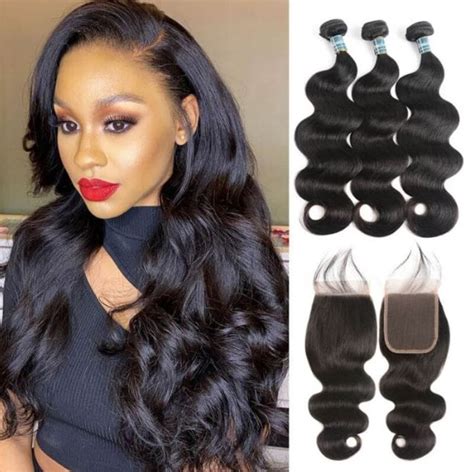Closure sew-ins are a versatile and protective hairstyling technique that has gained immense popularity in recent years. By seamlessly blending extensions with natural hair, closures allow individuals to achieve a variety of hairstyles while preserving the health and integrity of their own locks.

In this comprehensive article, we will explore the benefits, techniques, and best practices of closure sew-ins, providing you with all the essential information to make an informed decision about this transformative hair extension method.
1. Understanding Closure Sew-Ins
A closure sew-in involves attaching a hair extension piece, known as a “closure,” to the natural hair using a weaving or sewing technique. The closure is typically made of lace or mesh, with individual strands of hair knotted into it. By parting the natural hair into small sections and sewing the closure onto the scalp, the extensions can be seamlessly integrated, creating a natural-looking and secure hold.
2. Types of Closure Sew-Ins
2.1. Lace Closure Sew-Ins: Lace closures offer a more natural-looking hairline due to their sheer and transparent material. They allow for versatile styling options and are suitable for various hair textures.
2.2. Mesh Closure Sew-Ins: Mesh closures are more durable and less visible than lace closures. They provide a more breathable base and are ideal for individuals with coarser hair textures.
3. Benefits of Closure Sew-Ins
3.1. Enhanced Length and Volume: Closure sew-ins are an effective way to achieve longer, fuller hair without damaging natural hair. They offer a versatile styling solution for individuals seeking to add length or volume to their locks.
3.2. Protective Hairstyle: Closures sew-ins can help protect natural hair from breakage, heat damage, and environmental factors. By limiting the use of heat styling and reducing tension on the scalp, closures provide a protective barrier for delicate hair.
3.3. Hairstyle Versatility: Closures allow for a wide range of hairstyles, from sleek ponytails to intricate braids. The seamless integration of extensions enables individuals to experiment with different styles without compromising their natural hair’s health.
4. How to Get a Closure Sew-In
4.1. Consultation: It is crucial to consult with a professional stylist to determine the right type of closure, hair texture, and length for your desired look.
4.2. Preparation: Prior to the sew-in, the hair should be washed and conditioned to remove any product buildup.
4.3. Parting the Hair: The stylist will part the hair into small sections and apply cornrows or braids to create a base for the closure.
4.4. Sewing the Closure: The closure is sewn onto the base using a needle and thread or a sewing machine. The stylist will carefully secure the closure to the scalp to ensure a seamless blend.
4.5. Styling: Once the closure is attached, it is styled and blended with the natural hair using heat tools or other techniques.
5. Maintenance of Closure Sew-Ins
5.1. Wash and Condition: Closure sew-ins should be washed every 2-3 weeks to maintain cleanliness and avoid product buildup. Use sulfate-free shampoos and conditioners to preserve the extensions.
5.2. Deep Condition: Regular deep conditioning is essential to keep the extensions hydrated and prevent dryness. Deep condition every 4-6 weeks or as needed.
5.3. Styling: Heat styling should be minimized to avoid damage to the extensions. Use heat protectants when necessary.
5.4. Removal: Closures should be removed by a professional stylist every 6-8 weeks to allow the natural hair to rest and prevent tension.
6. Common Mistakes to Avoid
6.1. Improper Preparation: Failure to properly prepare the hair can lead to scalp irritation and breakage.
6.2. Tight Sewing: Excessive tension when sewing the closure can cause discomfort and damage to the hair.
6.3. Over-styling: Excessive heat styling can damage the extensions and cause premature wear.
6.4. Neglecting Maintenance: Lack of proper maintenance can lead to dryness, tangles, and shortened lifespan of the extensions.
7. Strategies for Effective Closure Sew-Ins
7.1. Choose an Experienced Stylist: Opt for a stylist who specializes in closure sew-ins and has a proven track record of delivering quality results.
7.2. Consider Hair Quality: Invest in high-quality hair extensions to ensure longevity and a natural-looking finish.
7.3. Avoid Overlapping: Prevent excessive tension and scalp irritation by ensuring the closure does not overlap with natural hair.
7.4. Blending Techniques: Use blending techniques such as feathering or cutting the hair at an angle to achieve a seamless transition between extensions and natural hair.
8. Creative Applications of Closure Sew-Ins
8.1. Ombre and Balayage: Create a stunning color gradient by using different shades of extensions or ombre/balayage techniques.
8.2. Accent Pieces: Use closures to add pops of color or highlights to enhance the overall look.
8.3. Hair Toppers: Closures can be used as toppers to add volume and coverage to thinning areas.
8.4. Braided Styles: Integrate closures into intricate braided styles to add length and depth.
9. Useful Tables
9.1. Types of Closures
| Type | Material | Appearance |
|---|---|---|
| Lace Closure | Sheer lace | Natural-looking hairline |
| Mesh Closure | Fine mesh | Durable and breathable |
9.2. Maintenance Schedule for Closure Sew-Ins
| Task | Frequency |
|---|---|
| Wash and Condition | Every 2-3 weeks |
| Deep Condition | Every 4-6 weeks |
| Styling | Minimize heat styling |
| Removal | Every 6-8 weeks |
9.3. Common Mistakes to Avoid with Closure Sew-Ins
| Mistake | Consequences |
|---|---|
| Improper Preparation | Scalp irritation, breakage |
| Tight Sewing | Discomfort, hair damage |
| Over-styling | Extension damage, premature wear |
| Neglecting Maintenance | Dryness, tangles, shortened lifespan |
9.4. Creative Applications of Closure Sew-Ins
| Application | Benefits |
|---|---|
| Ombre and Balayage | Color gradient, natural-looking finish |
| Accent Pieces | Pops of color, highlights |
| Hair Toppers | Volume, coverage for thinning areas |
| Braided Styles | Length, depth, intricate designs |
